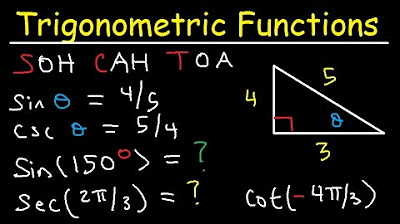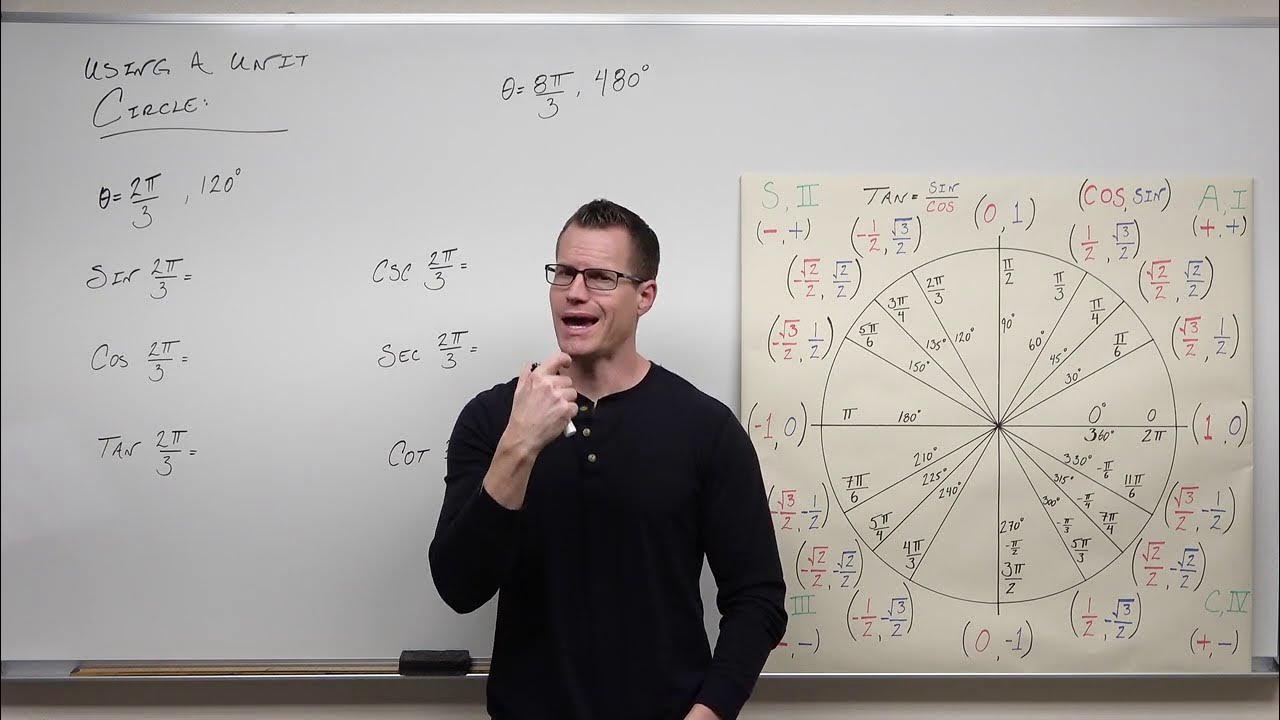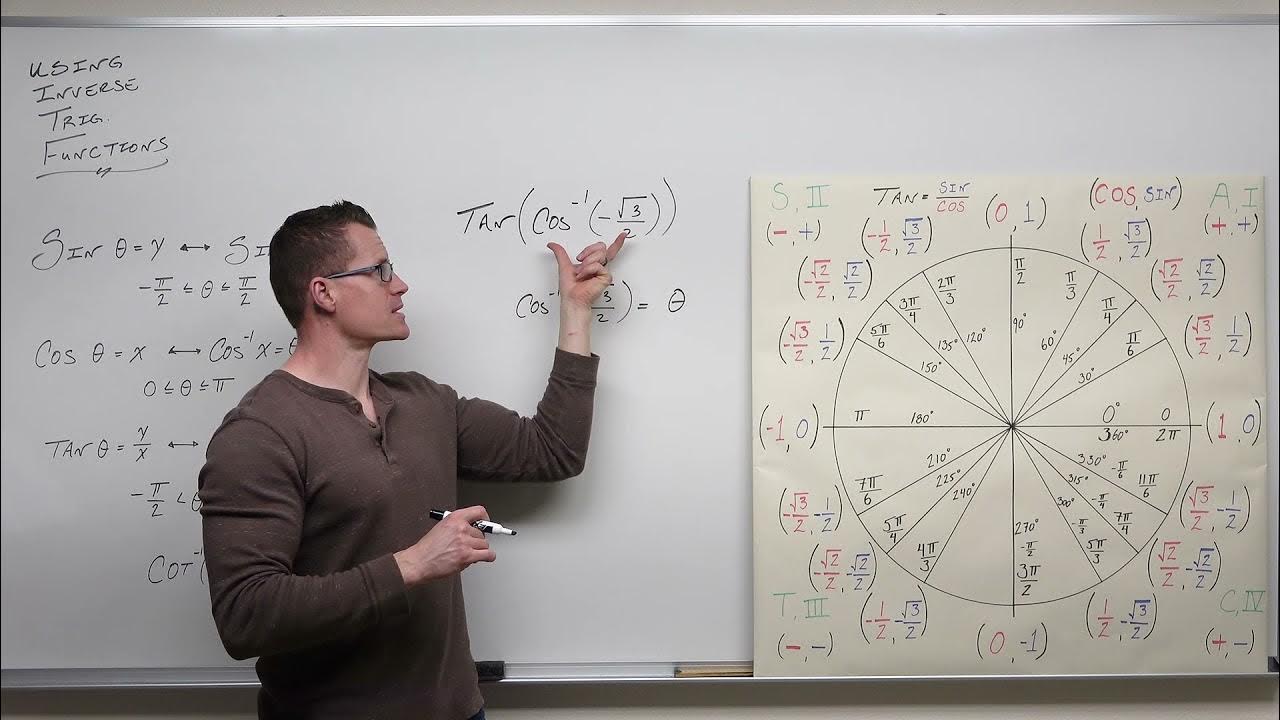Precalc 4.1-4.4 Review!
TLDRThis educational video script offers a comprehensive guide on radian and degree measures, coterminal angles, and trigonometric functions. It explains how to find positive and negative coterminal angles in degrees and radians, and demonstrates the process of calculating trigonometric values for given angles using the unit circle and hand trick. The script also covers special right triangles, SOHCAHTOA, and identifying the quadrant of angles based on trigonometric conditions. It concludes with solving problems involving trigonometric functions and their reciprocals, aiming to prepare viewers for an upcoming test.
Takeaways
- 😀 To find coterminal angles in degrees, add or subtract 360 degrees.
- 😀 To find coterminal angles in radians, add or subtract 2π radians.
- 😀 For radians, convert to a common denominator when adding or subtracting fractions.
- 😀 On the unit circle, use the hand trick to find coordinates for reference angles.
- 😀 When graphing angles in radians, adjust to a common denominator to identify the correct quadrant.
- 😀 Reciprocal trig functions like secant and cosecant can be found by flipping sine and cosine values.
- 😀 Reference angles are always between 0 and 90 degrees.
- 😀 Use SOHCAHTOA to solve for sides in right triangles, remembering to identify opposite, adjacent, and hypotenuse correctly.
- 😀 For special right triangles, memorize the side ratios for 30-60-90 and 45-45-90 triangles.
- 😀 Determine the quadrant of an angle based on the signs of sine, cosine, and tangent using the ASTC rule.
Q & A
What is the purpose of the video?
-The purpose of the video is to explain and demonstrate how to find coterminal angles in both degrees and radians, as well as to calculate trigonometric functions for various angles on the unit circle.
How can you find a coterminal angle in degrees?
-To find a coterminal angle in degrees, you can add or subtract 360 degrees from the given angle.
What is the relationship between radians and degrees when finding coterminal angles?
-For radians, you add or subtract 2π (two pi radians) to find coterminal angles, which is equivalent to adding or subtracting 360 degrees.
How does the 'hand trick' help in finding coordinates on the unit circle?
-The 'hand trick' is a mnemonic device that helps to determine the coordinates of points on the unit circle for given reference angles by using the angles formed by the fingers of your hand.
What is the reference angle for 2π/3 radians?
-The reference angle for 2π/3 radians is π/3 radians, which is equivalent to 60 degrees.
How can you rationalize a trigonometric function value that involves a radical in the denominator?
-To rationalize a trigonometric function value with a radical in the denominator, multiply the numerator and denominator by the conjugate of the denominator.
What trigonometric function is used to find the y-coordinate on the unit circle?
-The sine function is used to find the y-coordinate on the unit circle.
What is the relationship between the trigonometric functions and their reciprocal functions?
-The reciprocal functions are the cosecant (reciprocal of sine), secant (reciprocal of cosine), and cotangent (reciprocal of tangent).
How can you determine the quadrant in which an angle lies based on the signs of its trigonometric functions?
-You can determine the quadrant by considering the signs of the sine, cosine, and tangent functions. For example, if cosine is positive and sine is negative, the angle lies in the fourth quadrant.
What is the significance of the Pythagorean triple in the context of special right triangles?
-A Pythagorean triple is a set of three positive integers that satisfy the Pythagorean theorem (a² + b² = c²). In the context of special right triangles, such as 30-60-90 and 45-45-90 triangles, the sides are in a specific ratio that forms a Pythagorean triple, which simplifies the calculation of trigonometric functions.
How does the video script help in understanding the concept of reference angles?
-The script explains the process of finding reference angles by subtracting or adding fractions of a full circle (360 degrees or 2π radians) to the given angle, which helps in understanding how to simplify the angle for trigonometric calculations.
Outlines
📚 Understanding Coterminal Angles and Trigonometric Functions
This paragraph introduces the concept of coterminal angles, both in degrees and radians, and demonstrates how to find positive and negative coterminal angles for given angles in standard position. The explanation covers the process of adding and subtracting 360 degrees or 2π radians to find coterminal angles. It also shows calculations for angles in degrees and their corresponding radians, including simplifying fractions of π. The paragraph sets the stage for further exploration of trigonometric functions on the unit circle.
📐 Trigonometric Functions on the Unit Circle
The speaker delves into the specifics of finding the coordinates of a point on the unit circle corresponding to a given angle θ, as well as the exact values of trigonometric functions at that angle. The explanation includes drawing the unit circle, identifying the quadrant in which the angle lies, and using the hand trick to find the reference angle and coordinates. The process involves determining the x-coordinate (cosine) and y-coordinate (sine) and then calculating other trigonometric functions such as tangent, secant, and cosecant, including rationalizing the results where necessary.
🔍 Identifying Reference Angles and Quadrants
This section focuses on identifying reference angles and determining the quadrant in which an angle lies. The paragraph explains the process of graphing angles in degrees and radians, finding the reference angle by subtracting from a multiple of π (or 180 degrees), and understanding which quadrant the angle is in based on its position relative to the multiples of π/2 (or 90 degrees). The explanation is crucial for determining the signs of trigonometric functions in different quadrants.
📉 Evaluating Trigonometric Functions for Specific Angles
The speaker provides a step-by-step method for finding the exact values of trigonometric functions for specific angles, including how to handle negative angles by finding their positive coterminal angles. The explanation includes using the reference angle to determine the ordered pair on the unit circle and then calculating the trigonometric functions based on this pair. The paragraph also touches on the repetitive nature of these calculations and the importance of understanding the unit circle and reference angles.
📐 Applying SOHCAHTOA and Understanding Special Right Triangles
This paragraph introduces the mnemonic SOHCAHTOA for solving right triangles and explains how to find the sides of a triangle when two sides and the included angle are known. It also covers special right triangles, specifically the 30-60-90 and 45-45-90 triangles, and emphasizes the need to memorize the side ratios for these triangles. The explanation includes setting up equations to solve for unknown sides using the known side ratios and the Pythagorean theorem.
🧭 Determining Quadrants Based on Trigonometric Function Signs
The speaker explains how to determine the quadrant in which an angle lies based on the signs of its trigonometric functions. The explanation includes a mnemonic for remembering the signs of functions in each quadrant and how to use given conditions, such as the sign of cosine or tangent, to identify the quadrant. The paragraph also provides examples of how to use these conditions to find the correct quadrant for different angles.
📝 Solving Trigonometric Problems Using Given Conditions
The final paragraph discusses solving trigonometric problems by using given conditions to determine the signs of trigonometric functions and thus the quadrant of the angle. The explanation includes drawing triangles in the correct quadrant based on the signs of cosine and sine and using the Pythagorean theorem to find unknown sides. The paragraph concludes with a summary of the types of problems covered in the video, aiming to help students prepare for their upcoming tests.
Mindmap
Keywords
💡Coterminal Angles
💡Radians
💡Degrees
💡Unit Circle
💡Trigonometric Functions
💡Reference Angle
💡Hand Trick
💡Rationalizing
💡Pythagorean Triple
💡Special Right Triangles
💡Quadrants
Highlights
Introduction to the video on finding coterminal angles in both degree and radian measures.
Explanation of how to find coterminal angles by adding or subtracting 360 degrees.
Demonstration of converting between degrees and radians for coterminal angles using the relationship 360 degrees equals 2π radians.
Use of the 'hand trick' for finding coordinates on the unit circle corresponding to given angles.
Method for determining the coordinates of a point on the unit circle using reference angles.
Process of rationalizing the denominator when finding trigonometric function values.
Explanation of how to find the exact values of trigonometric functions at a given angle using the unit circle.
Mistake made during the explanation and the subsequent correction in the process.
Graphing angles in different quadrants to determine their reference angles.
Finding the quadrant containing an angle based on given trigonometric conditions.
Use of mnemonics like 'all students take calculus' to remember the signs of trigonometric functions in different quadrants.
Solving for unknown sides in right triangles using the Pythagorean theorem and trigonometric ratios.
Application of SOHCAHTOA mnemonic for solving right triangle problems.
Understanding the relationship between special right triangles and their angles and sides.
Using given trigonometric function values to determine the quadrant of an angle.
Drawing a triangle in the correct quadrant based on the signs of trigonometric functions.
Final summary of the problems covered in the video to prepare for a test on trigonometry.
Transcripts
Browse More Related Video

Trigonometric Functions of Any Angle - Unit Circle, Radians, Degrees, Coterminal & Reference Angles

How To Find The Exact Values of Trig Functions

Trigonometry

How to Use the Unit Circle in Trigonometry (Precalculus - Trigonometry 7)

An Indepth Look at Using Inverse Trig Functions (Precalculus - Trigonometry 21)

How To Find The Reference Angle In Radians and Degrees - Trigonometry
5.0 / 5 (0 votes)
Thanks for rating: